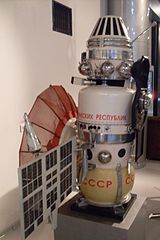Venera 4

Venera-4 model
|
|
| Mission type | Venus lander |
|---|---|
| Operator | Lavochkin |
| COSPAR ID | 1967-058A |
| SATCAT no. | 2840 |
| Mission duration | 127 days |
| Spacecraft properties | |
| Spacecraft | 1V (V-67) s/n 310 |
| Manufacturer | Lavochkin |
| Launch mass | 1,106 kilograms (2,438 lb) |
| Dry mass | 377 kilograms (831 lb) |
| Start of mission | |
| Launch date | 12 June 1967, 02:40 UTC |
| Rocket | Molniya-M |
| Launch site | Baikonur 1/5 |
| End of mission | |
| Last contact | 18 October 1967 |
| Orbital parameters | |
| Reference system | Heliocentric |
| Venus impact (failed landing) | |
| Impact date | 18 October 1967, 04:34 UT |
| Impact site | 19°N 38°E / 19°N 38°E (Eisila region) |
|
|
|
Venera 4 (Russian: Венера-4 meaning Venus 4), also designated 1V (V-67) s/n 310 was a probe in the Soviet Venera program for the exploration of Venus. It was the first successful probe to perform in-place analysis of the environment of another planet. It may also have been the first probe to land on another planet, with the fate of its predecessor Venera 3 being unclear. Venera 4 provided the first chemical analysis of the Venusian atmosphere, showing it to be primarily carbon dioxide with a few percent of nitrogen and below one percent of oxygen and water vapors. The station detected a weak magnetic field and no radiation field. The outer atmospheric layer contained very little hydrogen and no atomic oxygen. The probe sent the first direct measurements proving that Venus was extremely hot, that its atmosphere was far denser than expected, and that it had lost most of its water long ago.
The main hub of Venera 4 stood 3.5 metres (11 ft) high, its solar panels spanned 4 metres (13 ft) and had an area of 2.5 square metres (27 sq ft). The hub included a 2 meter long magnetometer, an ion detector, a cosmic ray detector and an ultraviolet spectrometer capable of detecting hydrogen and oxygen gases. The devices were intended to operate until entry into the Venusian atmosphere. At that juncture, the station was designed to release the probe capsule and disintegrate. The rear part of the hub contained a liquid-fuel thruster capable of correcting the flight course. The flight program was planned to include two significant course corrections, for which purpose the station could receive and execute up to 127 different commands sent from the Earth.
...
Wikipedia

